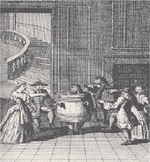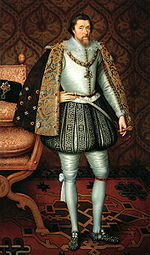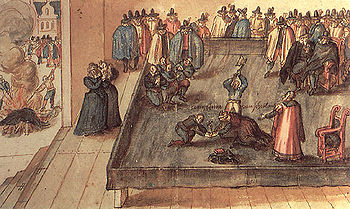
Portal:Early Modern Britain
Early Modern Britain
Early Modern Britain is the history of the island of Great Britain roughly corresponding to the 16th, 17th, and 18th centuries. Major historical events in Early Modern British history include the English Renaissance, the English Reformation and Scottish Reformation, the English Civil War, the Restoration of Charles II, the Glorious Revolution, the Treaty of Union, the Enlightenment and the formation of the First British Empire.
Selected article
Restoration literature is the English literature written during the historical period commonly referred to as the English Restoration (1660–1689), which corresponds to the last years of the direct Stuart reign in England, Scotland, Wales, and Ireland. In general, the term is used to denote roughly homogeneous styles of literature that centre on a celebration of or reaction to the restored court of Charles II. It is a literature that includes extremes, for it encompasses both Paradise Lost and the Earl of Rochester's Sodom, the high-spirited sexual comedy of The Country Wife and the moral wisdom of The Pilgrim's Progress. It saw Locke's Treatises of Government, the founding of the Royal Society, the experiments and holy meditations of Robert Boyle, the hysterical attacks on theatres from Jeremy Collier, and the pioneering of literary criticism from John Dryden and John Dennis. The period witnessed news become a commodity, the essay develop into a periodical art form, the beginnings of textual criticism, and the emergence of the stock market.
The dates for "Restoration literature" are a matter of convention, and they differ markedly from genre to genre. Thus, the "Restoration" in drama may last until 1700, while in poetry it may last only until 1666 and the annus mirabilis; and in prose it might end in 1688, with the increasing tensions over succession and the corresponding rise in journalism and periodicals, or not until 1700, when those periodicals grew more stabilised. In general, the term "Restoration" is used to denote the literature that began and flourished due to Charles II, whether that literature was the laudatory ode that gained a new life with restored aristocracy or the eschatological literature that showed an increasing despair among Puritans, or the literature of rapid communication and trade that followed in the wake of England's mercantile empire. (read more . . . )
Selected biography
James VI and I (19 June 1566 – 27 March 1625) was King of Scotland as James VI, and King of England and Ireland as James I. He ruled in Scotland as James VI from 24 July 1567, when he was only one year old, succeeding his mother Mary, Queen of Scots, who had been forced to abdicate. Regents governed during his minority, which ended officially in 1578, though he did not gain full control of his government until 1581. On 24 March 1603, as James I, he succeeded the last Tudor monarch of England and Ireland, Elizabeth I, who died without issue. He then ruled England, Scotland and Ireland for 22 years, often using the title King of Great Britain, until his death at the age of 58.
James achieved most of his aims in Scotland but faced great difficulties in England, including the Gunpowder Plot in 1605 and repeated conflicts with the English Parliament. According to a tradition originating with historians of the mid-seventeenth-century, James's taste for political absolutism, his financial irresponsibility, and his cultivation of unpopular favourites established the foundation for the English Civil War. Recent historians, however, have revised James's reputation and treated him as a serious and thoughtful monarch. Under James, the "Golden Age" of Elizabethan literature and drama continued, with writers such as William Shakespeare, John Donne, Ben Jonson, and Sir Francis Bacon contributing to a flourishing literary culture. James himself was a talented scholar, the author of works such as Daemonologie (1597) and Basilikon Doron (1599). Sir Anthony Weldon claimed that James had been termed "the wisest fool in Christendom", an epithet associated with his character ever since. (read more . . . )
Selected picture
A drawing of the execution of Mary, Queen of Scots. (read more . . . )
Selected quotes
| “ | But Shakespear's Magick could not copy'd be, Within that Circle none durst walk but he. |
” |
|
— John Dryden, The Tempest (1667), Prologue |
||
Did you know?
- ... that William Hogarth was paid sixty guineas to paint Taste in High Life (engraving pictured), a 1742 oil-on-canvas that pokes fun at the fashion of the upper class?
- ...that, on opening night of Samuel Johnson's Irene, audiences cried "Murder!" after seeing the main character strangled on stage?
- ... that Sir Clyomon and Sir Clamydes, an early Elizabethan stage play whose authorship is unknown, is thought to have influenced several of William Shakespeare's plays?
- ... that the British ship of the line HMS Colchester, launched in August 1744, was wrecked just two months later after running aground on her first commissioned voyage?




